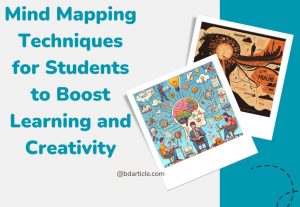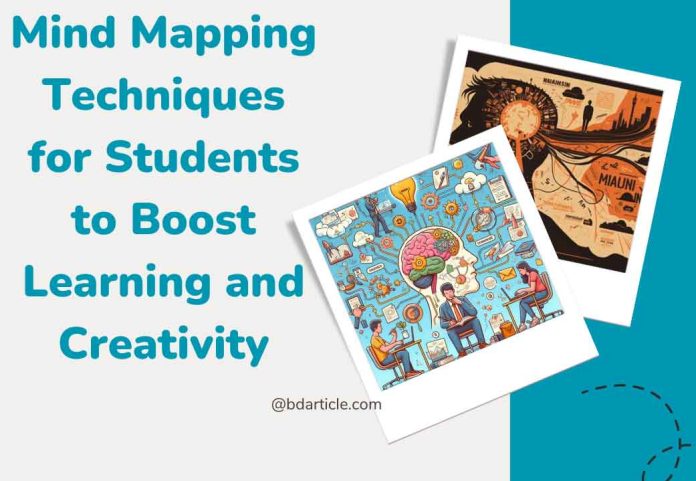Mind mapping techniques for students have become a game-changer in how learners absorb and organize information. This visual learning tool empowers students to break down complex topics, brainstorm effectively, and retain information in a structured and engaging manner. By leveraging mind mapping, students can achieve better academic outcomes while fostering creativity and problem-solving skills.

What is Mind Mapping?
Mind mapping is a visual representation of ideas and information structured around a central concept. It involves creating a diagram with the central idea in the middle, with related ideas branching outwards. Each branch contains subtopics and details, forming a hierarchical structure.
This technique works because it mirrors the brain’s natural way of processing and connecting ideas, making it an effective tool for understanding and memorizing concepts.
Benefits of Mind Mapping for Students
- Improves Comprehension
Mind mapping helps students understand and retain information by breaking down complex topics into digestible parts. - Enhances Creativity
Mind maps encourage free thinking, helping students generate unique ideas and solutions during brainstorming sessions. - Boosts Memory Retention
The visual and structured format of mind maps aids long-term memory retention, making it an excellent revision tool. - Organizes Ideas Effectively
For essays, presentations, and projects, mind mapping allows students to organize their thoughts and structure their work systematically. - Saves Time
Mind maps streamline the note-taking process, enabling students to focus on understanding rather than transcribing every detail.
Effective Mind Mapping Techniques for Students
1. Start with a Central Concept
Begin by writing the main topic or idea at the center of your page or digital canvas. Use a bold color or image to make it stand out.
2. Use Keywords and Phrases
Instead of lengthy sentences, use concise keywords or phrases on each branch. This keeps your map clean and easy to navigate.
3. Add Branches for Subtopics
Create branches extending from the central idea for each subtopic. Use curved lines instead of straight ones to make the map visually engaging.
4. Incorporate Colors and Images
Colors and images make your mind map more appealing and memorable. Assign different colors to each branch for better clarity.
5. Prioritize Information
Organize branches in order of importance or sequence to maintain logical flow. Place the most critical points closer to the central idea.
6. Review and Refine
Regularly revisit your mind map to update, refine, and add details as you learn more about the topic.
Applications of Mind Mapping for Students
1. Note-Taking in Classes
Mind maps are perfect for summarizing lectures. Students can quickly jot down key points and organize them into a cohesive structure.
2. Preparing for Exams
Use mind maps to condense large volumes of study material into easy-to-review formats, highlighting key concepts and connections.
3. Writing Essays and Reports
When planning essays or reports, mind mapping helps structure ideas, identify arguments, and create a logical flow for writing.
4. Group Projects and Collaboration
Students can use collaborative mind mapping tools like MindMeister to brainstorm and plan group projects efficiently.
5. Solving Problems
Mind mapping enables students to break down complex problems into manageable parts, analyze each aspect, and develop effective solutions.
Using Mind Mapping Tools
There are various tools available for digital mind mapping, including:
- XMind: Ideal for students seeking an intuitive platform with customizable templates.
- MindMeister: Offers cloud-based collaboration, making it great for group projects.
- SimpleMind: A user-friendly app perfect for quick brainstorming sessions.
Enhancing Focus with Mind Mapping
Mind mapping isn’t just a tool for academics; it’s also a way to improve focus and time management. For instance, creating a mind map for daily tasks can help students prioritize and allocate time effectively. Similarly, it aligns with strategies for staying present and mindful, like those highlighted in “Slow Travel Tips for Solo Adventurers to Fully Embrace the Journey.”
Combining Mind Mapping with Study Techniques
- Mind Maps and Flashcards
Combine mind mapping with flashcards for repetitive learning. Use mind maps for an overview and flashcards for detailed recall. - Mind Maps for Concept Mapping
Use concept maps to delve deeper into specific topics. While similar to mind maps, concept maps emphasize relationships between ideas. - Integrating Mind Maps in Study Groups
Collaborate with peers to create comprehensive mind maps, pooling collective knowledge for more effective learning.
Real-Life Success Stories of Mind Mapping
Many students have transformed their academic performance using mind mapping techniques. From preparing for competitive exams to tackling complex coursework, this method has proven to be an invaluable resource for learners at all levels.
For instance, a high school student preparing for final exams used mind mapping to visualize their study schedule and prioritize weaker subjects. Within weeks, they noticed an improvement in their retention and performance, attributing much of their success to the clarity and focus mind mapping provided.
Mind Mapping Beyond Academics
While primarily an educational tool, mind mapping has applications beyond the classroom. Professionals use it for strategic planning, writers for brainstorming ideas, and even individuals for personal development goals. Its versatility ensures it remains a lifelong skill for students.
Final Thoughts
Mind mapping techniques for students are a powerful way to enhance learning, creativity, and productivity. By adopting this method, students can break free from monotonous study routines and embrace a more engaging and effective approach to education.
Whether you’re taking notes, preparing for exams, or planning a project, mind mapping offers endless possibilities for organizing, understanding, and retaining information. With a little practice and the right tools, this technique can revolutionize the way students learn and grow.
#Mind_Mapping_Techniques_For_Students #Mind_Mapping_For_Learning #Mind_Mapping_In_Education

